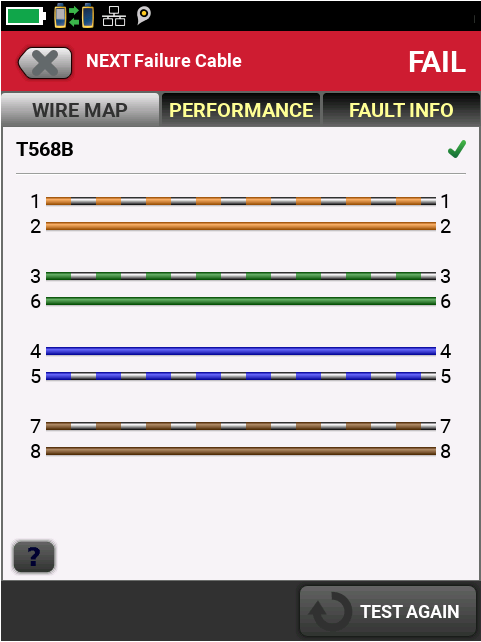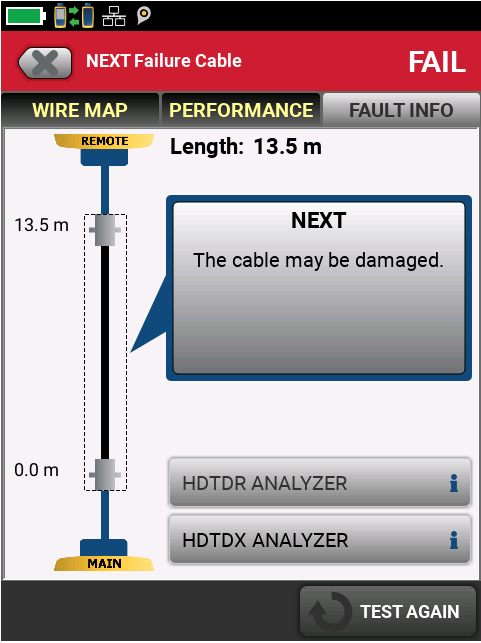Case Study 2 – NEXT Fails on DSX CableAnalyzer due to Cable
In this case study, the installer was getting a large number of NEXT failures when trying to certify a number of Category 6 Permanent Links. With the DSX CableAnalyzer, it is possible to discover why and where these links were failing.
After running a Test, the installer was presented with the following DSX CableAnalyzer result. By tapping on the “FAULT INFO” button, the most significant cause of the failure is identified. There may be more than one cause of the failure.


That Fault Info sure is helpful. Rarely, it will struggle to identify the cause of a fault. If the fault is not identified, here are the instructions for how to use HDTDX time domain analysis to find the cause of the failure.
단계 1
Find out which pair combination of NEXT is causing the failure
- Tap "Performance"
- Tap "NEXT"
- Tap the Right Arrow of PAIR to identify the worst pair combination
Here we see that Pair 1,2 – 4,5 is the cause of the NEXT failing. Make a note of this failing pair.
단계 2
Look at the HDTDX Analyzer trace for this marginal pair. X for NEXT failure.
-
Tap the back arrow in the top left corner
-
Tap the FAULT INFO tab
-
Tap the HDTDX ANALYZER button
- Tap the Right Arrow next to the PAIR to select only the 1,2-4,5 pair combination.
단계 3
Analyze the trace. What you are seeing is where the crosstalk is happening in the link. The cursor automatically goes to the largest source of crosstalk. In this case, ignore that. The two dotted yellow lines represent the ends of the test leads of the DSX CableAnalyzer. So you can assume the dotted yellow lines are the location of your first and last connection. You can “pinch and zoom” in on this event to get a better picture:
There is a cursor on the left image located at 13.1 meters, and showing a crosstalk event with a value of 35.80. While we do not want any connectors with more than 35, and this may be a cause of a failure, in this example the tester has identified that the cable is causing more significant NEXT.
As a rule of thumb (not in the standards), you should not expect more than 4 events in the cable that exceed 10%. On the right, we can see where that 10% line is, and we can see that there are at least 8 events, not including the first and last connectors, that are over the 10% line (enhanced for this image). This strongly suggests the NEXT failure is caused by the cable.
결론:
The cable is the principle cause of the NEXT failure. Re-terminating the connectors is not going to improve the result. This cable needs to be replaced.
팁:
For every batch of cable you receive, put aside at least 50 m (164 ft) of cable. If there becomes an issue with the cable and a dispute arises over whether it was damaged during the installation or manufactured incorrectly, you can take the cable you set aside and test it. You would pull it from the reel/box and lay it flat on the ground. Terminate it and test it. If the HDTDX trace looks the same as your installation, then it is time to call the cable vendor. To help, you will have a "virgin" piece of cable to be shipped back to the cabling vendor's lab for verification.





